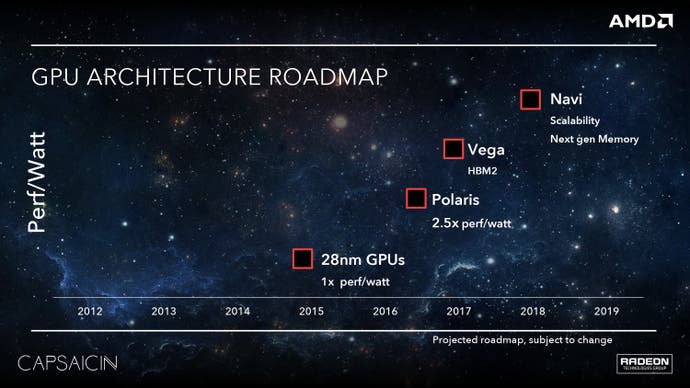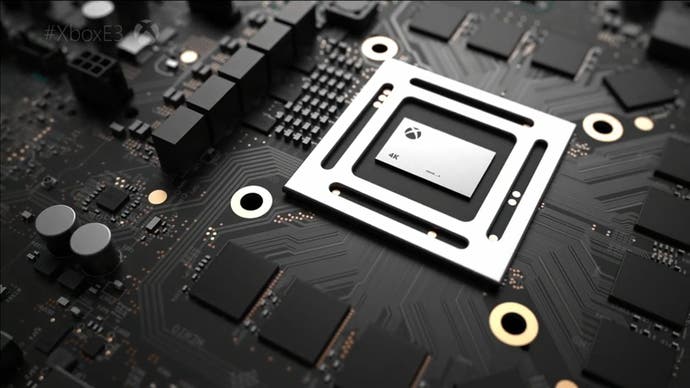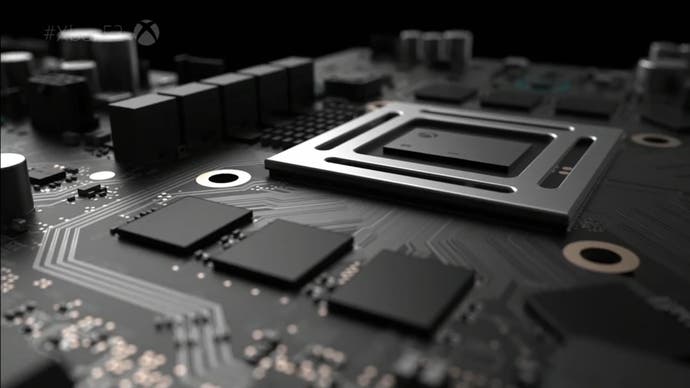Spec Analysis: Xbox Project Scorpio
Eight CPU cores, over 320GB/s of memory bandwidth, six teraflops of GPU power - how did they do that?
"Removing barriers... Innovation and the latest technology... delivering the world's most powerful console is something we absolutely want to do... the most powerful graphics processor that's been put into a game console... the highest res... the best frame-rate... no compromises... we can render at 60Hz... we can render fully uncompressed quality pixels... the best quality pixels... true 4K gaming..."
The pitch presented at the E3 press conference for Project Scorpio is plain and simple. While some of the claims sound a little bizarre or straight-out laughable (uncompressed pixels?), Microsoft aims to regain control of the technological high ground with its own mid-generation console refresh. What we're looking at here is an ambitious leap-frogging of the PlayStation 4K Neo in technological terms, with Microsoft utilising the top-tier parts available from hardware partner AMD - technology we've yet to see fully revealed in the PC space.
Actual performance figures and hard specs are thin on the ground, but there's enough information here for us to put together a picture on what Scorpio offers and whether it can indeed deliver on the claims made for it.
| PS4 | PS4K Neo | Xbox One | Project Scorpio | |
|---|---|---|---|---|
| CPU | Eight Jaguar cores clocked at 1.6GHz | Eight Jaguar cores clocked at 2.1GHz | Eight Jaguar cores clocked at 1.75GHz | Eight cores, speculation: up-clocked Jaguar or equivalent |
| GPU | 18 Radeon GCN compute units at 800MHz | 36 improved GCN compute units at 911MHz | 12 GCN compute units at 853MHz | Speculation: 56/60 GCN compute units at 800-850MHz |
| Memory | 8GB GDDR5 at 176GB/s | 8GB GDDR5 at 218GB/s | 8GB DDR3 at 68GB/s and 32MB ESRAM at max 218GB/s | Over 320GB/s bandwidth - speculation: 12GB of GDDR5 |
GPU: Much faster than PlayStation Neo
First up, let's discuss the GPU - the area of the spec that Microsoft is clearly most proud of. The rumoured six TFLOPs of processing power is confirmed, out-stripping the 4.2TF found in PlayStation Neo by quite some margin. It's around 40 per cent faster, calling to mind the advantage PS4 had over Xbox One.
We know how Sony has achieved its performance target - it is almost certainly utilising the AMD Polaris 10 graphics core, using 36 next-gen GCN compute units clocked at 911MHz. Essentially, it is a downclocked version of the Radeon RX 480 graphics card - AMD's upcoming $199 next-gen GPU, aimed squarely at the mainstream gamer while also offering good, entry-level VR capabilities. We can be fairly sure that this GPU is a cut-down version of a yet-to-be-seen product, quite possibly one with 40 compute units. By leaving a portion of the CUs deactivated, imperfect chips can be used from the production line - it's a tactic used on both PS4 and Xbox One, both of which have two offline CUs on the silicon.
However, based on the differential in spec between Neo and Scorpio, it's unlikely that the new Microsoft console uses Polaris at all. A 40 CU part would need a mighty overclock to hit 6TF, and based on the rendered imagery we've seen, the heating assembly planned for Scorpio looks a little lacklustre. With that in mind, our money is on a downclocked version of AMD's upcoming Vega technology.
Thanks to an AMD engineer rather unwisely posting a partial spec for Vega on his LinkedIn profile (!) we know that the fully enabled processor features 64 compute units. Assuming that this is cut down to 56 CUs (as in the Radeon R9 Fury, a pared back version of the 64 CU Fury X), a clock speed in the 830-850MHz region looks likely. Alternatively, and perhaps more likely, we could be seeing 60 CUs at 800MHz. Both represent a substantial increase over PlayStation 4K Neo, while the raw increase to performance over PS4 and Xbox One is obviously much larger.

Memory: 12GB of GDDR5?
Microsoft also dropped some hard figures in terms of memory bandwidth too, telling us that Scorpio has over 320GB/s of throughput. This gives us a couple of useful data points. Firstly, it's almost certainly the case that the ESRAM experiment on Xbox One is now a thing of the past - Microsoft will be following the approach pioneered by Sony in using a single, unified pool of memory based on PC graphics RAM technology. Which technology that is remains to be seen - will it be GDDR5 or the faster G5X found in Nvidia's GTX 1080?
The stated figure of 320GB/s can be achieved with 8GB of G5X using a 256-bit bus, or alternatively it could be using a 384-bit interface paired with 12GB of GDDR5. Now, this is where the stylised renderings of the Scorpio motherboard prove rather useful as we can count the amount of memory modules on the board - 12 memory chips are visible, confirming the use of current-gen memory tech and not the HBM2 we expect to see on Vega and Nvidia's next-gen Titan. This also seems to suggest that Scorpio has another big advantage over PlayStation 4K Neo - not just over 100GB/s more bandwidth, but also an additional 4GB of onboard RAM.
And this is a good thing for Microsoft in reaching its stated aim of handing in a worthy 4K experience - PlayStation Neo only offers up an additional 512MB of RAM for developers compared to the original PS4, meaning only limited space for higher resolution textures. Scorpio won't just deliver higher resolutions, but there'll be more space for higher detail textures. The only question will be on how quickly that RAM can be filled up - assuming that 5400rpm hard drives are still being used, 12GB will take a long time to fully occupy. On the flipside, we have heard from some developers that the 8GB of memory found in PlayStation Neo isn't quite enough to get the most out of 4K displays.

CPU: Eight cores, but what are they?
Microsoft didn't spend much time talking about the CPU technology found in Scorpio and if we were to be cynical about it, we'd suggest that it's because it's not going to show that much improvement over Xbox One. Just one specification was revealed - that Scorpio would have eight CPU cores, which brings it into line with the existing Xbox One, PS4 and indeed PS4K Neo.
There are two theoretical CPU technologies available to Microsoft here - the existing Jaguar cores (or perhaps a more modern version thereof), or AMD's upcoming Zen technology. Weighing the balance of probabilities, we'd say that it's unlikely to be Zen - if it were, we'd expect Microsoft to have made a much bigger deal of it. But secondly, what we know of the eight-core Zen is that it's a high-end desktop processor that's likely to require a large area of silicon. Integrating that alongside an already large GPU core seems overly ambitious.
With that in mind, we expect the disparity between CPU power and GPU in the consoles to grow even wider, and the importance of DX12 and GPGPU grows even more important - more tasks traditionally associated with the CPU will be hived off to the graphics hardware instead. Assuming Scorpio is indeed still using AMD's more mobile-orientated CPU cores, we should at least expect higher clock-speeds there - PlayStation Neo runs its cores at 2.1GHz vs the 'stock' 1.6GHz found on PS4.

Can Project Scorpio deliver the VR and 4K promises?
Based on existing AMD Radeon technology, the bottom line is that 6TF of GPU power isn't enough to power a convincing 4K experience. AMD's R9 390X offers around 5.9TF and struggles to push 4K resolution at anything like 30fps on modern PC titles. Now, we can assume that the move to the next-gen GCN architecture will give us some efficiency improvements, but it's hard to believe that this is enough to turn a 390X-level GPU into a top-tier Radeon R9 Fury X equivalent (8.4TF).
But it has to be said that we have seen developers start to extract more from Xbox One and PS4 than we see on equivalent PC parts - something borne out from the E3 demos of Gears of War 4 and Forza Horizon 3, which are - remarkably - running on hardware equivalent to AMD's £80 R7 360 graphics card. So maybe - maybe we will indeed see 4K native titles.
However, upscaling is equally as likely, and while it's not the true 4K we've been promised, this can produce some great results. For example, using Fury X on PC, we could run Star Wars Battlefront at 4K output but with an 85 per cent resolution scale. On top of that, we could increase quality settings over the console equivalents - and the end result looked phenomenal. We've also seen superb results from a straight 3200x1800 upscaled to 4K too. In terms of VR - that should be no problem. A 6TF Radeon GPU comfortably outperforms the baseline R9 290 and GTX 970 suggested for VR ready PCs.
Where does this leave PlayStation 4K Neo?
It's a remarkable turnabout. A good portion of PlayStation 4's success has been down to its spec advantage over Xbox One, combined with a focus on the hardcore player. Sony's technological advantage will be gone with the next wave of hardware - we already know that it cannot support true 4K resolution on cutting-edge games, because we've seen the internal documents that outline Sony's upscaling strategies for 4K display support (more on that soon). It's also unfeasible for Sony to produce a radically revised Neo - the silicon has been designed, developer kits have gone out. Matching Scorpio would require scrapping Neo's existing processor completely.
Just about the only option available to Sony is the route Microsoft chose for Xbox One in the face of PS4's higher specification - overclocking the processor. It could inch the Neo a little closer to the target Scorpio spec, but hitting 6TF there is off the table: Sony would need a 40 CU Polaris 10 clocked at 1.2GHz to hit the same level. And that wouldn't address the 100GB/s bandwidth deficit or the 4GB memory gap we suspect will separate Neo and Scorpio.
But there is an elephant in the room here: price. Microsoft's brief to AMD in producing this behemoth of a semi-custom design looks pretty obvious - to create the most powerful console possible. The GPU is more powerful and it's going to be larger, which means it's going to be more expensive to produce. Meanwhile, assuming we're right about the 4GB of additional memory, that's not going to be cheap either - when we attended AMD's Munich launch event for Fury X and the Radeon 300 series, we were told that adding an additional 4GB of GDDR5 to the R9 390/390X cost around them around $30 per unit. In short, we would not be surprised to see Scorpio cost significantly more than Neo - maybe even $100 more.
But there's certainly going to be pressure on Sony here - particularly as its next console is targeted at the hardcore player, who wants the very best. If Neo launches this year, it'll have a healthy headstart over Scorpio. However, if we're looking at a March 2017 launch, many may consider until Scorpio appears - especially as the new hardware stands to deliver a tangibly more impressive technological upgrade over the established PlayStation 4.



